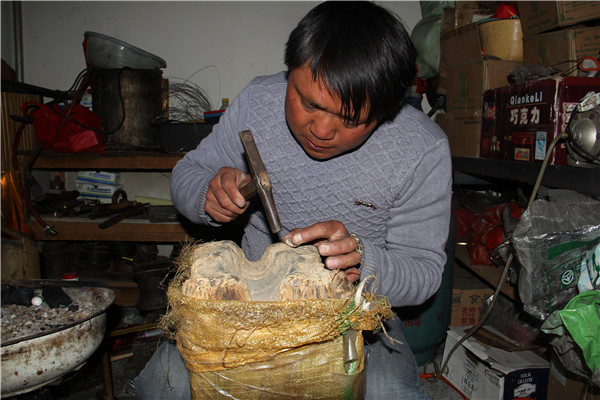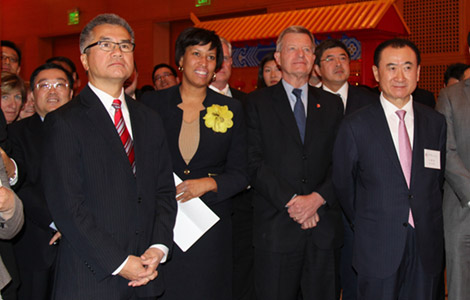Silversmith carries on ancestral tradition
Updated: 2015-03-27 11:38
By Palden Nyima and Phuntsog Tashi in Lhasa, Tibet(China Daily USA)
|
||||||||
 |
|
Li Fuhua takes nearly two hours to finish a silver decoration for a bracelet. Photos by Norzom |
Strong demand in Lhasa for items produced by ethnic Bai
In Lhasa, the capital of the Tibet autonomous region, ethnic Bai silversmiths are using their ancestral skills to make Tibetan-style objects including ornaments, jewelry and religious items.
One of them, Li Fuhua, 36, owns a shop in the west section of the Lingkor route, the biggest Buddhist pilgrim circumambulation path in Lhasa, and the sound of his constant hammering draws the attention of passers-by.
With his deeply suntanned skin, it is hard to believe that Li is not a native of Lhasa. He settled in the city 11 years ago after traveling to many cities in China and now regards Lhasa as his second home.
The city's residents are fond of silver items, and their constant demand has helped Li develop his skills.
He was born in the Dali Bai autonomous prefecture in Yunnan province. The region has produced generations of silversmiths and is famous for producing silver items.
At age 18, Li learned to become a silversmith from his father, who was the third generation engaged in the craft.
"The old rule was that it takes at least six years to become a silversmith - three years for learning, and three years for paying back the master," Li said.
- 'Behind-the-scenes' visit at Paris Zoological Park
- Migrants risk lives crossing into Europe
- US denies visa to young man for transplant
- Germanwings' co-pilot 100 percent fit to fly: Lufthansa CEO
- Germanwings' co-pilot 100 percent fit to fly: Lufthansa CEO
- Voice recordings show one pilot locked out cockpit

 Across America over the week (from March 20 to 27)
Across America over the week (from March 20 to 27)
 Walking tall
Walking tall
 Press photo competition winners announced
Press photo competition winners announced
 Strange but true: Gator takes a stroll on Florida golf course
Strange but true: Gator takes a stroll on Florida golf course
 Top 9 hot-selling foreign products for Chinese babies
Top 9 hot-selling foreign products for Chinese babies
 French photographer captures Beijing in the '80s
French photographer captures Beijing in the '80s
 Top 10 steel producers in China
Top 10 steel producers in China
 Highlights of China Fashion Week
Highlights of China Fashion Week
Most Viewed
Editor's Picks

|

|

|

|

|

|
Today's Top News
'Made in China' to 'Made in USA'
Motive examined after 'deliberate crash'
Tornadoes kill one in Oklahoma
Kissinger: US, China should seize chances to cooperate
'Sky Net' tracks fugitive officials
Apple Pay would face battle in China: Analysts
Michigan firm gets $1 billion Chinese contract
Teen's DNA project nets student Intel science award
US Weekly

|

|






